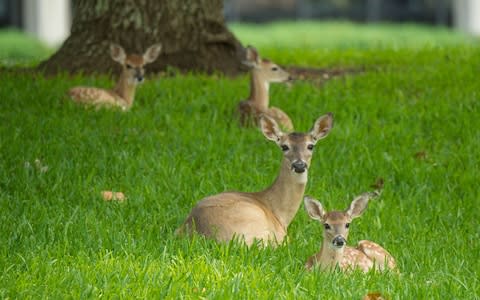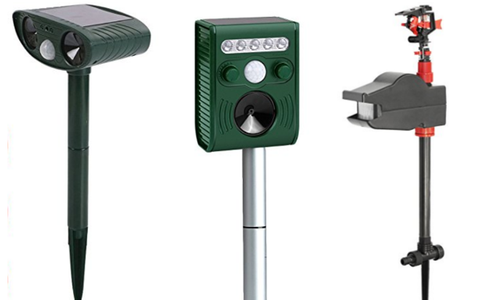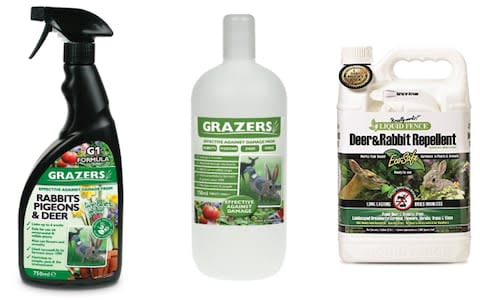How (and how not) to stop deer eating your garden

Every spring my mum and I get the fanciful notion that we’re going to give her veg patch another go. We’ll be totally self-sufficient by summer, we tell ourselves. By next spring, we’ll be entering the local county show for the most sizeable marrow and comically formed carrot. But after laboriously digging over a suitable area, sculpting neat little rows of seeds promising sweet peas, cabbages, lettuces and courgettes, we always wake up a few weeks later to find our seedlings have suffered the same fate that made us vow never to garden again. Deer, however Bambi-esque they may look, wreak havoc in the garden.
There are roughly one million deer living in the UK today, all of which take immense pleasure in munching on runner beans, beetroot, azaleas, roses and geraniums alike. Despite the widespread frustration felt by gardeners, there are, unusually, very few controlled experiments that have looked into effective ways to deter deer, so the jury’s out on a definitive solution. The best we can do is to ask around to see what has worked for others, and pray it works for us, too. Here are a few methods we’ve found to succeed (or not), as shared by experts, friends, and of course, my mum.

Odour
The British Deer Society recommends installing an odour-based deterrent to ward deer off tempting plants, though I would question whether I want their suggestions of diesel-soaked cloth strips, muslin bags of human hair or, erm, urine, among my vegetables. Furthermore, once you’ve grappled with the implications of collecting the contents of your shower drain and instructing any males of the family to wee on your plot, you then face the depressing reality that this form of protection is only going to last as long as it takes for the British weather to do what it does best - tip down with rain.
Better, according to other sources, to get a few bars of soap, push them onto some bamboo sticks like a severed head at the Tower of London, and stick them in the ground around the plants you wish to protect.
Tactical planting
Though I've witnessed deer plough through crops of beetroot, lettuce and broad beans, my mint patch has remained untouched. Deer, though you wouldn't believe it, can be picky about what they choose to graze on. Both the RHS and National Deer Society give a comprehensive list of 'deer resistant plants', as well as a list of plants you can grow to provide an alternative source of food for the deer. Of course, how much of that alternative food source you need to provide to stop them going after your prized roses is open to question. I can fill my cupboards with as many fruit and nuts as I please, but come 11pm and I'm always going to push them aside and reach for the far tastier biscuits at the back.

Sound and light devices
Numerous different products claim to ward off unwanted wildlife through the use of ultrasonic signals, squirting water, flashing lights and, in the case of a device brought home by Mum one day, a motion sensor that begins playing BBC Radio 4 when set off. Unfortunately we think the deer took a liking to The Archers and scheduled their visits to catch the afternoon’s episode.
Our verdict on all scare devices, therefore, is that unless you vary the method used to scare them, the deer will quickly grow accustomed to it and realise they pose no threat, leaving Bambi and Co. free to gorge on your garden. So a sound and/or light device would perhaps be suitable for anyone wanting to ward off the occasional stray deer, but not for a garden where they are a regular problem.

Chemical sprays
An affordable and relatively easy solution to the problem of unwanted nibblers might be to invest in a reliable chemical spray, such as Grazers G1 formula. Sprays are relatively quick, they do no harm to your plants, and they aren’t poisonous to the deer or pets. The downside of these sprays is that, though claiming to last up to six weeks, we found the effectiveness of the spray diminishes significantly after rainfall, meaning there was a regular race to the veg patch between us and the deer after a downpour.

Fences
If DIY is your thing, then a fence might be the best option for you. It is agreed by the RHS, the British Deer Society and The Forestry Commission that one of the most effective ways of keeping deer out of the garden is to build a fence. It has to be tall, buried at least a foot deep, and made with wire that won’t allow the deer to become easily tangled in it; fishing line and other thin, invisible wires are advised against. Further advice how to put up a fence according to the breed of deer you’re dealing with can be found on the Forestry Commission website.
A dog
And finally, the gold standard in deer protection. From experience, the inconvenient truth is that the best form of deer deterrent is simply to have a dog. Gem, below, was fat, lazy and totally inoffensive, but her unexpectedly loud bark and determination to chase down whatever entered the garden meant that our flowers and vegetables were protected from hungry deer. Sadly, we don’t have a Gem any more, so Mum’s garden is at the mercy of whatever saunters in to search for an afternoon snack. Her absence has, however, confirmed that if you want your garden to be both bountiful and beautiful, you need to get yourself a Gem.


